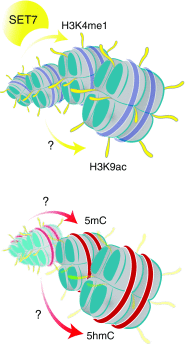Epigenetics in diabetic nephropathy, immunity and metabolism
- PMID: 29128937
- PMCID: PMC6448927
- DOI: 10.1007/s00125-017-4490-1
Epigenetics in diabetic nephropathy, immunity and metabolism
Abstract
When it comes to the epigenome, there is a fine line between clarity and confusion-walk that line and you will discover another fascinating level of transcription control. With the genetic code representing the cornerstone of rules for information that is encoded to proteins somewhere above the genome level there is a set of rules by which chemical information is also read. These epigenetic modifications show a different side of the genetic code that is diverse and regulated, hence modifying genetic transcription transiently, ranging from short- to long-term alterations. While this complexity brings exquisite control it also poses a formidable challenge to efforts to decode mechanisms underlying complex disease. Recent technological and computational advances have improved unbiased acquisition of epigenomic patterns to improve our understanding of the complex chromatin landscape. Key to resolving distinct chromatin signatures of diabetic complications is the identification of the true physiological targets of regulatory proteins, such as reader proteins that recognise, writer proteins that deposit and eraser proteins that remove specific chemical moieties. But how might a diverse group of proteins regulate the diabetic landscape from an epigenomic perspective? Drawing from an ever-expanding compendium of experimental and clinical studies, this review details the current state-of-play and provides a perspective of chromatin-dependent mechanisms implicated in diabetic complications, with a special focus on diabetic nephropathy. We hypothesise a codified signature of the diabetic epigenome and provide examples of prime candidates for chemical modification. As for the pharmacological control of epigenetic marks, we explore future strategies to expedite and refine the search for clinically relevant discoveries. We also consider the challenges associated with therapeutic strategies targeting epigenetic pathways.
Keywords: Chromatin; Diabetes; Diabetic complications; Diabetic nephropathy; EWAS; Epigenetics; Histone; Innate immune memory; Vascular.
Conflict of interest statement
Duality of interest
The authors declare that there is no duality of interest associated with this manuscript.
Contribution statement
All authors were responsible for drafting the article and revising it critically for important intellectual content. All authors approved the version to be published.
Figures


Similar articles
-
Epigenetics and Trained Immunity.Antioxid Redox Signal. 2018 Oct 10;29(11):1023-1040. doi: 10.1089/ars.2017.7310. Epub 2017 Nov 21. Antioxid Redox Signal. 2018. PMID: 28978221 Free PMC article. Review.
-
Update: the role of epigenetics in the metabolic memory of diabetic complications.Am J Physiol Renal Physiol. 2024 Sep 1;327(3):F327-F339. doi: 10.1152/ajprenal.00115.2024. Epub 2024 Jul 4. Am J Physiol Renal Physiol. 2024. PMID: 38961840 Review.
-
Epigenetic Risk Profile of Diabetic Kidney Disease in High-Risk Populations.Curr Diab Rep. 2019 Feb 7;19(3):9. doi: 10.1007/s11892-019-1129-2. Curr Diab Rep. 2019. PMID: 30730019 Free PMC article. Review.
-
Epigenetic mechanisms.Contrib Nephrol. 2011;170:57-65. doi: 10.1159/000324944. Epub 2011 Jun 9. Contrib Nephrol. 2011. PMID: 21659758 Free PMC article. Review.
-
The role of epigenetics in the pathology of diabetic complications.Am J Physiol Renal Physiol. 2010 Jul;299(1):F14-25. doi: 10.1152/ajprenal.00200.2010. Epub 2010 May 12. Am J Physiol Renal Physiol. 2010. PMID: 20462972 Free PMC article. Review.
Cited by
-
Epigenetic Modifications in Peripheral Blood as Potential Noninvasive Biomarker of Diabetic Retinopathy.Transl Vis Sci Technol. 2019 Dec 18;8(6):43. doi: 10.1167/tvst.8.6.43. eCollection 2019 Nov. Transl Vis Sci Technol. 2019. PMID: 31871829 Free PMC article.
-
Berberine protects diabetic nephropathy by suppressing epithelial-to-mesenchymal transition involving the inactivation of the NLRP3 inflammasome.Ren Fail. 2022 Dec;44(1):923-932. doi: 10.1080/0886022X.2022.2079525. Ren Fail. 2022. PMID: 35618411 Free PMC article.
-
Dnmt3a and Dnmt3b-Decommissioned Fetal Enhancers are Linked to Kidney Disease.J Am Soc Nephrol. 2020 Apr;31(4):765-782. doi: 10.1681/ASN.2019080797. Epub 2020 Mar 3. J Am Soc Nephrol. 2020. PMID: 32127410 Free PMC article.
-
Cellular Senescence and Regulated Cell Death of Tubular Epithelial Cells in Diabetic Kidney Disease.Front Endocrinol (Lausanne). 2022 Jun 28;13:924299. doi: 10.3389/fendo.2022.924299. eCollection 2022. Front Endocrinol (Lausanne). 2022. PMID: 35837297 Free PMC article. Review.
-
Activated Histone Acetyltransferase p300/CBP-Related Signalling Pathways Mediate Up-Regulation of NADPH Oxidase, Inflammation, and Fibrosis in Diabetic Kidney.Antioxidants (Basel). 2021 Aug 26;10(9):1356. doi: 10.3390/antiox10091356. Antioxidants (Basel). 2021. PMID: 34572988 Free PMC article.
References
-
- DCCT/EDIC The Diabetes Control and Complications Trial/Epidemiology of Diabetes Interventions and Complications Research Group Retinopathy and nephropathy in patients with type 1 diabetes four years after a trial of intensive therapy. N Engl J Med. 2000;342:381–389. doi: 10.1056/NEJM200002103420603. - DOI - PMC - PubMed
-
- Hammes HP, Klinzing I, Wiegand S, Bretzel RG, Cohen AM, Federlin K. Islet transplantation inhibits diabetic retinopathy in the sucrose-fed diabetic Cohen rat. Invest Ophthalmol Vis Sci. 1993;34:2092–2096. - PubMed
Publication types
MeSH terms
Substances
Grants and funding
LinkOut - more resources
Full Text Sources
Other Literature Sources
Medical
Research Materials

